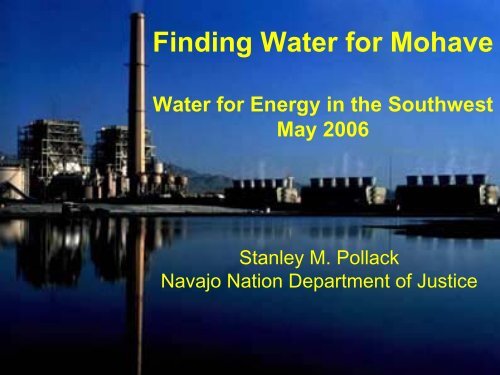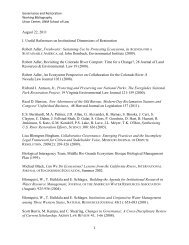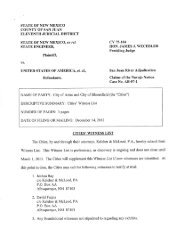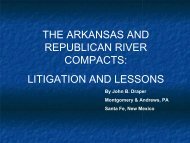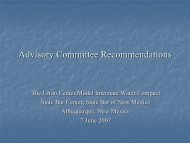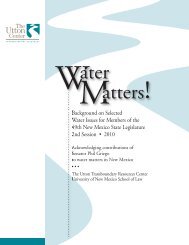Stanley M. Pollack, Navajo Nation Department of Justice - Utton ...
Stanley M. Pollack, Navajo Nation Department of Justice - Utton ...
Stanley M. Pollack, Navajo Nation Department of Justice - Utton ...
You also want an ePaper? Increase the reach of your titles
YUMPU automatically turns print PDFs into web optimized ePapers that Google loves.
Finding Water for MohaveWater for Energy in the SouthwestMay 2006<strong>Stanley</strong> M. <strong>Pollack</strong><strong>Navajo</strong> <strong>Nation</strong> <strong>Department</strong> <strong>of</strong> <strong>Justice</strong>
Black Mesa Coal Slurry Preparation Plant
http://www.shundahai.org/bigmtbackground.html
Mohave Generating StationOperated by Southern California Edison
Black Mesa Slurryline
Lease No. 14-2020-0603-8580“Lessee has the right and license, inconnection with the operation <strong>of</strong> coalmining on the leased lands: to . . .develop and utilize water for use in itsmining operations.”
Peabody Black Mesa MineJobs: 300Royalties/Taxes: $20 – 25 M/yrWater: 4,000 afyPhoto: Enei Begaye
All technical studiesconclude that Peabody’suse <strong>of</strong> N Aquifer water hasminor & temporary impacts.
However, the use <strong>of</strong> N aquiferwater for the slurry continuesto be controversial.
<strong>Department</strong> <strong>of</strong> the InteriorAlternative Transportation Study1992 - 93
Transportation by Railroad<strong>Department</strong> <strong>of</strong> the InteriorAlternative Transportation Study, 1993• Construction Cost: $413 Million• 1993 Dollars• Not include retr<strong>of</strong>it costs at powerplant• Not include rights-<strong>of</strong>-way costs• Operating Cost: $43 Million/year• Incremental Transportation Cost:$21/ton
Transportation by Railroad<strong>Department</strong> <strong>of</strong> the InteriorAlternative Transportation Study, 1993• Alternative requires continued use <strong>of</strong> 600acre-feet <strong>of</strong> water per year.• ATS Study did not consider environmentalimpacts associated with railroad.• Railroad to Mohave Generating Station couldmake Black Mesa Coal obsolete.• Requires additional Colorado River water.• Would take at least six (6) years to construct.
Transportation by Railroad<strong>Department</strong> <strong>of</strong> the InteriorAlternative Transportation Study, 1993The ATS Study concluded that becausethe “incremental cost per ton <strong>of</strong> railtransport dwarfs the incremental costs<strong>of</strong> the four water alternatives . . . the railtransportation alternative should berejected.”
Colorado River OptionLake Powell Pipeline• Preferred option in LCRsettlement• Requires ColoradoRiver allocation• Upper-to-Lower Basintransfer• Arizona consentrequires Colorado Riversettlement• Not feasible within timeconstraints
The <strong>Navajo</strong> <strong>Nation</strong>is located in betweenthe Upper and LowerBasins <strong>of</strong> theColorado River
Lake Powell in the Upper BasinBlack Mesa Mine in the Lower Basin
Possible Colorado River intakes
Jackass Canyon DiversionBelow Lee Ferry
Jackass Canyon Diversion
Grand Canyon Diversionis Challenging• No Upper-toto-Lower Basintransfer, but• Requires Colorado Riverallocation• Opposition from Central Arizona• Environmental opposition
Jackass Canyonbelow Lee Ferry
<strong>Navajo</strong> MainstemColorado River Claim• Threatens central Arizona water supply• <strong>Navajo</strong> <strong>Nation</strong> v. <strong>Department</strong> <strong>of</strong> the InteriorBreach <strong>of</strong> trust claim against the United States for failing toconsider the <strong>Navajo</strong> <strong>Nation</strong>’s s claims to the waters <strong>of</strong> theColorado River in various river management decisions bythe Secretary.
Other Options Evaluated• Non-water alternatives; methane, trucking• “Brackish Water” & effluent• “Reverse pipeline” from Kingman to carryColorado River water• Moving the slurry plant to the Upper Basin(Limited Upper Basin apportionment)• Etc., etc.
C Aquifer Project
C Aquifer• Areal extent: 27,000 mi 2• Storage estimated 600 to 900 million AF• Discharge: 174,000 af/yr• Current uses: 90,000 af/yr• Current tribal uses: 1,000 af/yr• Home to Little Colorado River spinedace
Year 2010 C-Aquifer Withdrawals ForExisting Major Industrial Water UsesSource: Hopi – Western<strong>Navajo</strong> Water SupplyStudy, 2004C-Aquifer Study Area(proposed 6000 af/yrindustrial Use)13,500 af/yrTotal Non-Tribal:58,500 af/yr13,000 af/yr20,000 af/yr12,000 af/yr<strong>Navajo</strong> <strong>Nation</strong> <strong>Department</strong> <strong>of</strong> Water Resource – Water Management Branch, Nov-12-2005C-Aquifer Information
Investigations indicatethat the C Aquifer is aviable alternative.
C Aquifer Project Requirements• Settlement <strong>of</strong> outstanding litigation betweentribes and the companies.• New fuel supply agreement between Peabodyand Southern California Edison.• New water agreement concerning C Aquifer.• Municipal water development for tribes.• Retr<strong>of</strong>it <strong>of</strong> MGS with pollution control equipment.
Opposition to the use <strong>of</strong> waterfor coal operations persists.


